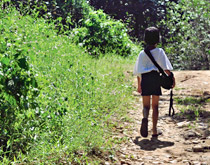The drawing ends as quickly as it began. The teenage artist-a refugee from the southeastern Asian country of Burma-puts down her pencils.
"I want to draw where I am from, but I can't remember. All I remember is the mountains," she says.
She is far from alone in her plight. During the past 60 years, the military conflict in Burma has forced millions of families to leave their homes and seek shelter along the Thailand/Burma border, taking with them only what they could carry on their backs.

Courtney Wittekind witnessed the hardship firsthand by spending several months volunteering throughout Thailand and Burma before enrolling at Carnegie Mellon in fall 2009. Images of the refugees stayed with her throughout her freshman and sophomore years, as she both wondered and marveled at how Burmese refugees survived, regrouped, and found hope in the porous borders of Thailand. Last spring, while pursuing her BHA intercollege degree in art and anthropology, she decided she should return to the region.
Her vision for a study-abroad program wasn't an easy one to execute. Although many of her professors admired her passion to help the Burmese refugee community through art and anthropological studies as part of an academic research project, they were concerned for her safety. It would take her to "a no-man's-land" of indiscernible, unpaved roads largely undefined by the Thai and Burmese governments. Undaunted, Wittekind applied for the Boren Scholarship, a funding opportunity for U.S. students to add an international and language component to their educations, particularly in underrepresented populations. She booked her airfare to Bangkok, knowing she would travel there regardless of the Boren outcome. She got it.
Wittekind says her two-semester journey along the Burmese border has given her a new perspective. In addition to compiling hundreds of photographs that documented the anthropological aspect of her studies, she learned that most refugee children don't feel sorry for themselves. Instead, they find comfort in what she describes as "communal suffering." Meaning, they realize they're not alone in having witnessed killings. The tragic bond brings them strength instead of tears.
Through daily art assignments, Wittekind says she helped many of the children open up about their lives. Painful memories frequently surfaced and were captured in sketches. In the next moment, though, they often reached for another blank sheet of paper. One stroke at a time, they drew the beauty and simplicity of their land.
-Joanna Smiley (DC'02)



